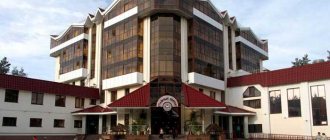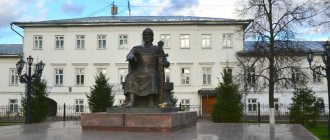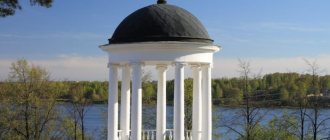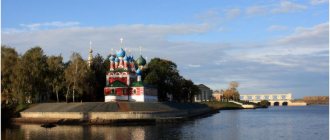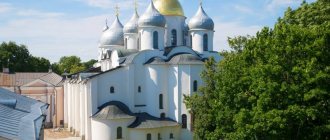Bobruisk: main attractions for tourists
There are several attractions in Bobruisk that, even at the level of the entire Mogilev region, are worth seeing. Below is what tourists try to visit in the city, even if they are here for just one day.
Bobruisk fortress
- Address: Karbysheva, 11.
A fortress structure of the early 19th century, erected on the orders of Emperor Alexander I. The project was developed by Karl Oppermann. Construction took place in 1810 and 1812. and ended right before Napoleon's invasion.
The fortress preserves the memory of the events of that Patriotic War; it played an important role in it. Its significance was noted in his book “Heroes of the Patriotic War” by A.I. Mikhailovsky-Danilevsky, Major General of the Imperial Army.
The Bobruisk fortress is a citadel in the form of a polygon and consists of eight bastions, similar in type and design to the legendary Brest fortification itself.
Both of these protective structures are remarkable from both a historical and architectural point of view. There are no other similar facilities in the Republic of Belarus. Today, the Bobruisk Fortress is considered the oldest architectural monument of the city.
Selishche Dednovo
- Coordinates on the map: 53.127981, 29.169348.
The archaeological site reveals ancient pages of the history of the area to scientists and tourists. The ancient settlement was discovered by the Soviet and Belarusian archaeologist P.F. Lysenko in the late 1970s. in the suburbs of Bobruisk, in the village of Dednovo. Today it is an urban area, which is the southeastern outskirts.
The settlement dates back to the 10th-13th centuries AD. Excavations carried out here in the 1990s allowed us to go deeper into history. For example, among the finds was a coin from the Roman Empire from the time of Marcus Aurelius (2nd century).
Bobruisk Museum of Local Lore
- Address: Socialist, 56.
The main museum of the city will tell you about the history and culture of Bobruisk and its surroundings, about various eras in the life of the population and historical events. Among the museum exhibits are archaeological finds made during excavations in Dednovo. We are talking about utensils, handicrafts, coins, including the numismatic artifact mentioned above.
The exhibition pays special attention to two Patriotic Wars - with Napoleon in 1812 and the Great War in 1941-45. A special exhibition is dedicated to the latter, telling about the heroic defense of the city and its post-war restoration. In addition to ethnographic, historical and cultural subjects, the museum also tells about the natural features of the regions.
Socialist Street
- Address: st. Socialist.
One of the most famous streets of Bobruisk, passing through the entire historical part of the city. Is pedestrian. Leads from the central market to the banks of the Berezina River. Socialist Street is the center of city life, home to many city attractions and cultural institutions. The architectural appearance of the street was formed in 1909-1913.
Initially, the street was called Muravyovskaya, in honor of the local governor general N.M. Muravyov. He went down in history as an active participant in the suppression of the Polish uprising of 1863. After 1917 it was renamed Socialist. During the Second World War, during the occupation of Bobruisk, the Germans christened it Gaupstrasse; after the liberation of the city, it was returned to its Soviet name, which it still bears.
Beaver Monument
- Address: intersection of Karl Marx and Socialist streets.
A funny waterfowl - the beaver - once upon a time gave its name to the city. They say that in ancient times beaver fishing flourished in these places, hence the name. The anthropomorphic figurine of a beaver, dressed in pre-revolutionary attire, appeared in the city not so long ago, at the beginning of this century, but has already become one of the symbols of Bobruisk.
A competition was held to create a monument to the beaver, in which the project of local master V. Gavrilenko won. His creation was installed at the very beginning of Socialist Street, not far from the market.
The importance of the city in the modern world
Bobruisk, whose sights have existed for more than 600 years, was first mentioned as a city in documents in 1387. At that time it was part of the territory of the Principality of Lithuania. But for the first time people settled in these places in the Stone Age, which is confirmed by archaeological finds. During the 5th-6th centuries, a settlement of ancient Slavic tribes appeared on the banks of the Berezina River.
The settlement owes its name to the massive beaver pelt industry. In ancient times, the population was actively engaged in beaver hunting and fishing. Today it is a large regional center of the Mogilev region with petrochemical, woodworking and timber industries, machine-building plants and food production enterprises.
The area of the city is just under 100 square meters. km.
Beautiful architecture and museums in Bobruisk
Through the museums of Bobruisk you can learn a lot of interesting things about its past, appreciate the unique historical features and facts. Architectural landmarks allow you to visually see history through beautiful buildings that are many years old.
House of Merchant's Wife Katsnelson
- Address: International, 25.
The one-story, L-shaped wooden mansion belonged to the wealthy bourgeois Katsnelson, a representative of one of the most famous merchant families of Bobruisk. The house was built in 1912 and is an example of Art Nouveau architecture. For some time the building was rented by the police department.
In 1918, when Bobruisk was occupied by the Bolsheviks, a revolutionary committee headed by P.F. was located in the former merchant's house. Ravinsky. This period in the history of the building is immortalized with a memorial plaque. Today, the historical building performs a cultural and educational function - it houses the district library.
The building of the children's library named after. A.N. Ostrovsky
- Address: Komsomolskaya, 52.
Another library in the city, intended for young readers, is also located in a historical building. The one-story house built in 1900 with a facade divided by pilasters and crenellated turrets is considered a monument to the Art Nouveau style. Initially it was a merchant's mansion.
His fate was interesting. During the war, the Nazis placed their headquarters in it, and after the Great Patriotic War, the Soviet authorities gave the building to an orphanage. In the early 1990s. After the restoration of the building, the children's library was moved here. Spacious rooms with four-meter ceilings were perfect for a “temple of reading.”
The building of the Bobruisk Hotel
- Address: Sovetskaya, 97.
The hotel complex of the same name in the city is not only a place for comfortable accommodation of tourists, but also one of the significant architectural monuments and “calling cards” of Bobruisk, which is worth seeing on excursions.
It was built in the late 50s according to the design of V. Zubov and is considered an outstanding example of majestic civil architecture of the middle of the last century. The Soviet-style elegant building has rounded shapes and adorns the intersection of three streets in the historical center.
Tetris house or birdhouse house
- Address: Pushkin street.
One of the most unusual, original and attractive buildings in Bobruisk is the house at the intersection of Minskaya and Pushkin streets. It was built in Soviet times - in the era of the dominance of standard architecture. The residential building with one-room apartments stood out strikingly against the general background; the architects embodied “Japanese motifs” in it.
The highlight is the round windows, reminiscent of “portholes,” and the house itself looks as if it was assembled from assorted cubes. Due to its strange appearance, local residents initially dubbed it the “birdhouse house,” and later, with the advent of the popular video game design, it was given another name, “Tetris house.”
Former merchant mansion and Olympic Glory Museum
- Address: Pushkina, 211.
An example of architectural eclecticism from the beginning of the last century is the building of the representative office of the Olympic Committee in Bobruisk. The one-story house is L-shaped, the facade is richly decorated.
The central entrance attracts attention with a portico with two columns. The architectural monument is included in the list of objects of historical and cultural significance of Belarus. Local historians suggest that the first owner of the mansion was a breeder named Mierburg.
During Soviet times, a maternity hospital was located here; later the building was given to the City Executive Committee. Today there is a Museum of Olympic Glory, telling about the achievements of Belarusian Olympic athletes and the history of the sports movement in the country.
Gatovsky's estate in the village of Krasny Bereg
- Address: Isaeva street, 16, Krasny Bereg agricultural town.
In the suburbs of Bobruisk, remarkable noble estates have been preserved, which have become a must-see destination on many tourist routes around Belarus. The noble estate of the late 19th century in the village of Krasny Bereg is the only estate in Belarus, made in an eclectic manner, which also uses neo-Moorish style.
The house and manor buildings are the creation of the architect Viktor Aleksandrovich Shreter. Next to the house there is a park designed by the Polish gardener Frantisek Szanior. The estate is located in the northern part of the agricultural town of Krasny Bereg near the Dobosna River. It belonged to the family of Major General Mikhail Semenovich Gatovsky.
It is often called the Gatovsky-Kozel-Poklevsky estate. Kozel-Poklevsky is the husband of Gatovsky’s daughter, he did a lot for the development of the estate. After the 1917 revolution, the estate was nationalized and was used to house educational institutions. Officially considered an object of historical and cultural heritage of the country.
Bulgakov estate “Dobosna” in the village of Zhilici
- Address: Mira street, 5, agricultural town Zhilici.
In the vicinity of Bobruisk, in the village of Zhilichi, there is a palace and park complex in the style of late classicism, which is an object of historical and cultural heritage of the Republic of Belarus. The estate was built by order of the nobleman Ignat Bulgak for his family in the 30s of the 19th century. The architect of the estate ensemble is Karol Podchaszynski. There is a park around the estate and outbuildings.
After the revolution, the estate building housed an orphanage. Since 2009, restoration work has been carried out in the manor complex, but it is open for inspection. The Zhilich historical complex-museum is opened in one of the outbuildings. Here you can study in detail the history of the estate, see the model of the Bulgakov palace, as well as objects of peasant life from different historical periods.
Bobruisk Art Museum named after. Poplavsky
- Address: Maxim Gorky, 28.
The Art Museum was created in Bobruisk in 2009 on the basis of the Exhibition Hall, which belonged to the Belarusian Union of Artists and had been operating in the city since 1975. Over the many years of work, the Exhibition Hall opened exhibitions that allowed residents of the republic and guests to get acquainted with the professional art of artists. But the hall did not have its own funds.
Since 2004, specialists began to collect the museum fund, and today it contains collections of paintings, graphics, ceramics, decorative and applied arts, photography, stones and minerals. The museum is named after the People's Artist of the Republic of Belarus Georgy Georgievich Poplavsky. His collection of prints is kept in the same gallery.
Leisure
The city is home to the largest ice palace, Bobruisk Arena, where mass skating and training of hockey teams are held. The sports complex is located on Kuibysheva Street, building 11. You can visit the palace with a guide on weekdays from 8 a.m. to 4 p.m. Rides are held in the evenings and on weekends.
The city also has its own equestrian club, where you can take riding lessons in the arena or rent equipment for a horseback ride through the forest. The cost will be up to 20 rubles. at one o'clock. The club is located on Baharova Street, 108.
The Lesnoy water sports complex with a swimming pool and a games gym is located at 5 km of the Minsk highway, open daily from 8 to 21, with a lunch break from 14 to 15.
Bobruisk temples, churches and shrines
Bobruisk is notable not only for its Orthodox churches, but also for its religious buildings of other faiths and movements. The city's religious monuments demonstrate the dialogue of cultures in the Belarusian lands, where both the Slavic Orthodox and Jewish populations and adherents of the Catholic faith lived and live.
Cathedral of St. Nicholas the Wonderworker
- Address: Sovetskaya, 76.
The wooden church was built at the beginning of the 17th century; at first it was Uniate, then it became Orthodox. The reconstruction of the structure, which resulted in the appearance of a brick cathedral, close to its modern appearance, took place in 1892-1894.
The brick cathedral did not have a chance to receive parishioners for long. With the advent of Soviet power, its religious activities ceased; for some time it resumed its work during the Great Patriotic War, but after it it was closed again, and a swimming pool was organized on its premises.
The modern history of the existing Orthodox church began in the new millennium - in 2003. Nowadays the cathedral has the status of a cathedral; there is a center of Orthodox culture within it, which you can also visit on your own.
Church of St. George
- Address: Karbysheva, 4.
Near the main entrance to the Bobruisk fortress there is a majestic white stone temple. It appeared here at the beginning of the last century, namely in 1905-1907, when the fortification itself was recognized as having lost its strategic importance and the restriction on the construction of buildings next to it was lifted. In 1916, the last monarch of the Russian Empire, Nicholas II, visited the new temple.
Under Soviet rule in the 1920s. the church was closed and partially destroyed. The bell tower was dismantled, the domes were knocked off the temple. The premises were used for various purposes. Over the years, they housed a clothing factory and a warehouse. In 1990, the temple again opened its doors to believers. The church was restored, returning it to its former appearance as a monument of church architecture in the Russian style.
Church of the Immaculate Conception of the Blessed Virgin Mary
- Address: Oktyabrskaya, 121.
On Oktyabrskaya Street there is a red-brick, austere religious building belonging to the Catholic Church. The baroque style church was built at the beginning of the last century under the leadership of priest Jan Krasovsky.
During the Soviet years it did not function except for the period when the city was under German occupation. The temple was partially destroyed. Nowadays, in 1990, the temple was consecrated by Catholic Archbishop Tadeusz Kondrusiewicz and became operational again.
Synagogue
- Address: Socialist, 36.
The only Jewish temple in the city testifies to the Jewish religious culture in Bobruisk. The synagogue was built here at the end of the 18th century. It was blown up by the Bolsheviks and rebuilt again in the late 1990s. A rabbi from Israel arrived here to conduct services according to the Jewish rite.
Today, the institution is open to everyone; excursions are held here, where tourists can learn more about the Jewish religion and rituals. There is information about plans to open a museum at the Bobruisk synagogue.
Transport
Citizens travel by the following types of public transport: buses, trolleybuses and minibuses. The city has about 50 intra-city routes operated by more than 150 transport units. The cost of a travel ticket for one trip is 0.6 Belarusian rubles.
Belarusian taxi is also quite a budget and convenient form of transport. The cost of a taxi ordered through a dispatcher will cost an average of 4.5-5 local rubles. Daily rental of an economy class car will start from 50 Belarusian rubles.
Monuments of Bobruisk: sculptures and monuments
In Bobruisk you can also look at interesting monuments and sculptural compositions, against which you can take excellent photographs.
Monument to V.I. Lenin
- Address: Lenin Square.
Throughout the post-Soviet space in cities there are statues of the leader of the world proletariat, the first leader of the Soviet state, Vladimir Ilyich Lenin. The Bobruisk monument is noteworthy as having artistic value.
The bronze monument, created by P. Belousov and N. Myznikov in 1969, is included in the list of objects of historical and cultural heritage and is considered an outstanding example of Soviet monumental art, which is why it appears partly on souvenir products.
Monument-tank at the grave of General B.S. Bakharov
- Address: Victory Square.
A memorial in memory of the soldiers who fell during the Great Patriotic War was installed at the burial site, on Zhukov Square, in the center of Bobruisk. Boris Sergeevich Bakharov, commander of a tank battalion during the liberation of the city from the Nazi invaders in 1944, rests here.
A T-34 battle tank was installed at his grave, which became the central object of the memorial complex, opened in 1958. To mark the anniversary of Victory Day, the square and the memorial on it were reconstructed twice - in 1985 and in 2005.
Monument to soldiers of the 1st Belarusian Front
- Address: st. Socialist.
The monument, dedicated to the heroic battles for the city and the courage of the soldiers who drove the enemy into the “Bobruisk Cauldron”, appeared in the city ten years after the liberation of the Belarusian lands, in 1954. The monument is made in the form of a figure of a Soviet soldier with a machine gun in his hands. Located on Socialistheskaya Street - on the right bank of the Berezina River.
Monument to Internationalist Soldiers
- Address: Socialist, 115.
In 1998, architect Eduard Agunovich and sculptor Vladimir Slobodchikov created a bronze monument to the residents of Bobruisk who died in hot spots while performing military duty. The monument represents a star with angel wings. Female figures are leaning towards her, symbolizing mothers, sisters, daughters who mourn their deceased relatives. The names of the heroes are stamped between the rays of the star.
Monument to Shura Balaganov
- Address: Pushkina, 194.
The character of the book by I. Ilf and E. Petrov Shura Balaganov is embodied in bronze on the street of Bobruisk - his two-meter figure was installed in 2013. In the book “The Golden Calf”, through the lips of this hero, glory is given to this city. Shura considered it a highly cultural settlement in Belarus. The inscription at the monument reproduces the corresponding fragment of a literary work.
Distinctive features of the city
The location in the semi-closed Central Berezina Plain, densely indented by rivers and drainage canals, left its mark on the weather conditions of the area with a temperate continental climate. Winter is cool and short, the average temperature in January is -4 degrees. Summer is warm and humid, starting in May and lasting until September.
Bobruisk climate by month
The city is located in an area of numerous mixed forests with a predominance of oak, pine, birch and alder. Also common are maple, linden, ash and aspen. Eutrophic and steppe meadows have been preserved in the river floodplains.
The fauna of forests is represented by the following common representatives:
- moose;
- red deer;
- wild boars;
- roe deer;
- martens;
- caresses;
- hares;
- hedgehogs
The European bison is a rare protected object of the Red Book. Endangered species also include the badger, European lynx, eagle owl and godwit.
The swamps are home to turtles, toads, frogs, lizards and snakes. The city's population exceeds 217.5 thousand people. It is considered the 7th largest city in Belarus by population, the 2nd in the Mogilev region, and the largest non-regional center in the country.
The main national composition of the population is represented by:
| Nationality | Percent | Number of thousand people |
| Belarusians | 83,6 | 180,5 |
| Russians | 13,2 | 28,7 |
| Ukrainians | 1,9 | 4,1 |
| Jews | 0,3 | 0,65 |
| Poles | 0,2 | 0,43 |
| Other peoples | 1,3 | 2,8 |
In confessional terms, the predominant directions are:
- Protestantism;
- Orthodoxy;
- Judaism;
- Old Believers;
- Catholicism.
Don’t miss the most popular article in the section: What to see in Belarus - attractions and interesting places.
Where to go in Bobruisk: entertainment for children and adults
There is less entertainment for children in Bobruisk than in St. Petersburg or Kazan, but your children will still not get bored. There is also entertainment for adults.
Central Park of Culture and Leisure
- Address: International, 45a.
A place for active entertainment and relaxation is the main City Park, spread over an area of 22 hectares. In addition to the vast green area, there are food outlets and many attractions where little visitors to the park can ride both independently and with their parents. There is also an assortment of extreme entertainment. Those who wish can practice their accuracy at the shooting range.
Mogilev Regional Drama and Comedy Theater named after V. I. Dunin-Martsinkevich
- Address: Socialist, 105.
Back in the 30s, the first theater in Belarus with a mechanical stage was created in Bobruisk; it was soon moved to the “regional capital” - Mogilev, and here a collective farm and state farm troupe was formed, which gave rise to a drama and comedy theater of regional significance. The theater was officially opened in 1944.
Since 1977, it has been named after the classic of Belarusian literature, the outstanding playwright Vikenty Ivanovich Dunin-Martsinkevich. His white marble bust is installed near the theater building.
The attraction's repertoire includes about fifty performances for adults and children. Classic and modern Belarusian drama is presented on stage. The troupe has a staff of more than thirty people, including people's artists of Belarus.
Children's entertainment complex "Nemo"
- Address: st. 50 years of the Komsomol, 34, 3rd floor.
Those who want to entertain their children in Bobruisk can go to the Nemo entertainment complex, which will give children a lot of positive emotions. Here, young adventurers will find a confusing and intriguing three-tier labyrinth, where you can find a lot of interesting things.
Those who like to crawl, ride slides and jump on a trampoline will be able to relax their souls. The entertainment center offers creative programs and competitions for children of all ages, and there are halls for holding children's holiday events. The child will be delighted with visiting this place.
How to get there
Bobruisk, whose attractions attract an increasing number of tourists every year, is conveniently located on the railway transport branch of the pan-European corridor. You can get there by direct train from Moscow in 12-14 hours. There is also a good railway connection with Minsk, about 10 trains per day, travel time from 2 to 3.5 hours.
The fastest option is to fly to Minsk by plane in 2.5 hours, and then by train, train or bus. You can get there by your own car or on one of the direct buses from Moscow in 15-17 hours.
Camp "Children's Science City"
Discussion: 16 comments
- Olga Konovalova:
09/14/2014 at 14:21Larisa, the last photo is not visible. Check it out.
As for the attractions, it’s a nice town, but the swimming pool in the cathedral is blasphemy!!! Thank God that now everything will return to normal.
Answer
Larisa:
09/14/2014 at 15:30
Thank you, I corrected the photo. Of course, it’s one thing to have a swimming pool on the site of a cathedral (like in Moscow), but here it’s completely inside. In the small photo you can see that they are diving under the arches and swimming to the “altar”...
Answer
Olga Konovalova:
09.14.2014 at 17:17
Now I can see the pool, and the last photo is visible.
Answer
09/15/2014 at 19:59
How interesting this Bobruisk is! The first thing that catches your eye is the surrounding cleanliness and well-kept buildings. And beavers are simply magnificent! A speaker on the street - greetings from the past, it’s a pity that there are few of them left. Thank you for introducing me to a new city for me! I would love to stroll along the cozy streets! *THUMBS UP*
Answer
- Larisa:
09/16/2014 at 16:42
The city is generally quite large, only the center is small, as it should be. There are almost no ancient monuments left due to history... But those that exist are replenished :). And the people there are friendly. My son met a girl, so every day we went to visit her grandparents, and returned with gifts from their garden.
Answer
Tatiana Vysotskaya:
09/17/2014 at 07:37
So now you can go on vacation to these kind people, as if you were relatives!))))
Answer
Larisa:
09/17/2014 at 11:01
Tanya, well, not that much))))
Answer
09.23.2014 at 10:45
Interesting city! The beavers really touched me
